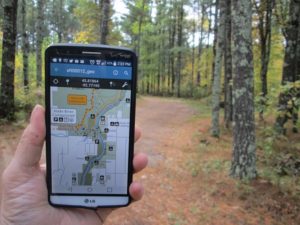
Minnesota State Park maps, especially those with which you are unfamiliar, can be daunting. And the idea of getting lost in a forest? No thanks.
But no more.
The Minnesota Department of Natural Resources (DNR) has produced six new, state-of-the-art maps to make navigation easier for explorers, hunters, and anyone else touring one of our majestic state forests.
Forrest Boe, director of the DNR Forestry Division, had this to say about the current project “The DNR has updated six state forests with 53 more to go. This five-year effort will include updating maps for all of Minnesota’s state forests.”
The six new maps are now available (just in time for hunting season) and cover more than 240,000 acres of state forest land and thousands of miles of trails.
There are two new options: A geoPDF map, and a redesigned paper map. The geoPDF map allows users to download a map onto a mobile device, and uses a variety of map apps to track location as a blue dot on the screen. If you have ever used Google Maps to walk around an area, it’s basically the same thing. As Laura Duffey, DNR state forest map project coordinator, describes it, “The little blue dot that appears on the map on my phone goes with me whether I’m on or off-trail. This feature lets people know exactly where they are in a state forest—no more getting lost.”
The new paper maps are more user-friendly, and highlight unique recreation features of each forest and include pop-out maps for popular campgrounds and day-use areas.

The six state parks available on geoPDF maps are as follows:
- Paul Bunyan State Forest in Cass and Hubbard counties
- Badoura State Forest in Cass and Hubbard counties
- Croix State Forest in Pine County
- Huntersville State Forest in Cass, Hubbard and Wadena counties
- Lyons State Forest in Wadena County.
- Chengwatana State Forest in Pine and Chisago counties
The maps are also more detailed than previous versions, and highlight the endless recreation opportunities in state forests, such as hiking, mountain biking, birding, berry picking, cross-country skiing, hunting, and horseback, ATV and snowmobile riding. Many state forests also offer campgrounds, fishing piers, boat launches, swimming beaches, and picnic areas.
Further information on geoPDF-available forests:
The Paul Bunyan and Badoura state forests are popular spots for hunters. Combined, they contain two campgrounds and day-use areas, four off-highway vehicle trails, five wildlife management areas (WMA), two ruffed grouse management areas, and four state game refuges. They also have hiking, biking, snowmobiling and skiing trails.
The Huntersville and Lyons state forests are also incredibly popular. Each state forest contains four WMAs and several miles of trails and roads for off-highway vehicles. Additionally, the Huntersville State Forest offers two campgrounds, a horse campground, and 24 miles of designated horse trails.
The St. Croix State Forest offers a variety of year-round recreation opportunities. It has 20 miles of horseback trails and a horse campground with 56 campsites. In the winter, snowmobilers can enjoy 42 miles of trails, while in the summer mountain bikers can cruise 25 miles of trails. The Boulder Campground and day-use area has 22 secluded campsites and access to Rock Lake for swimming, fishing and boating.
The Chengwatana State Forest contains the Snake River Campground, and several miles of off-highway motorcycle and all-terrain vehicle trails. Three state water trails run through the forest: Kettle River, Snake River, and St. Croix River. Snowmobilers also use the Matthew Lourey State Trail, which runs through the forest. The new maps also shows locations of National Park Service campsites along the St. Croix River.
Digital, geoPDF maps are available at www.mndnr.gov/stateforests.
A (free) paper map is also available at your local DNR office. You can also email the DNR Info Center at info.dnr@state.mn.us, or call (888) 646-6367, Monday-Friday 8am – 8pm and Saturdays 9am – 1pm
















